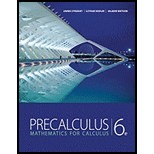
Concept explainers
(a)
The significance of the slope and T- intercept in given equation.
(a)
Explanation of Solution
The average surface temperature equation is given,
Where, T is temperature in
The general equation of the line is,
Substitute T for y, t for x in above general equation of the line, the equation becomes,
Compare the above equation from equation (1), to find the value of m,
m, which is the slope of the equation (1) and which represents the rise of every year.
Thus, the value of m is 0.02 so, the slope represents an increase of
(b)
To find: The value of average global surface in 2050 by using equation (1).
(b)
Answer to Problem 66E
The value of average global surface in 2050 is
Explanation of Solution
Given:
The average surface temperature equation is,
Where, T is temperature in
Calculation:
Calculate the value of t, from 1950 to 2050 years,
Substitute 100 for t, in equation (1) to find the value of T,
The average global surface value will be in 2050 is
Chapter 1 Solutions
EBK PRECALCULUS: MATHEMATICS FOR CALCUL
 Calculus: Early TranscendentalsCalculusISBN:9781285741550Author:James StewartPublisher:Cengage Learning
Calculus: Early TranscendentalsCalculusISBN:9781285741550Author:James StewartPublisher:Cengage Learning Thomas' Calculus (14th Edition)CalculusISBN:9780134438986Author:Joel R. Hass, Christopher E. Heil, Maurice D. WeirPublisher:PEARSON
Thomas' Calculus (14th Edition)CalculusISBN:9780134438986Author:Joel R. Hass, Christopher E. Heil, Maurice D. WeirPublisher:PEARSON Calculus: Early Transcendentals (3rd Edition)CalculusISBN:9780134763644Author:William L. Briggs, Lyle Cochran, Bernard Gillett, Eric SchulzPublisher:PEARSON
Calculus: Early Transcendentals (3rd Edition)CalculusISBN:9780134763644Author:William L. Briggs, Lyle Cochran, Bernard Gillett, Eric SchulzPublisher:PEARSON Calculus: Early TranscendentalsCalculusISBN:9781319050740Author:Jon Rogawski, Colin Adams, Robert FranzosaPublisher:W. H. Freeman
Calculus: Early TranscendentalsCalculusISBN:9781319050740Author:Jon Rogawski, Colin Adams, Robert FranzosaPublisher:W. H. Freeman
 Calculus: Early Transcendental FunctionsCalculusISBN:9781337552516Author:Ron Larson, Bruce H. EdwardsPublisher:Cengage Learning
Calculus: Early Transcendental FunctionsCalculusISBN:9781337552516Author:Ron Larson, Bruce H. EdwardsPublisher:Cengage Learning





